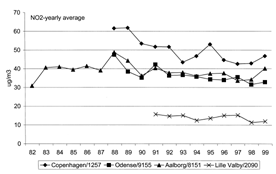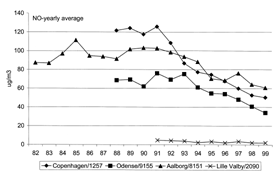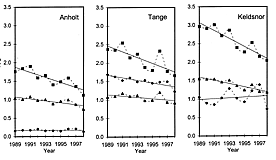
Chemistry International
Vol. 22, No. 5, September 2000
2000, Vol. 22
No. 5 (September)
..Chemistry in Chile
..IUPAC Prize
..Air Quality in Denmark
..Highlights from the Web
..Reports from Symposia
..New Projects
..News and Notices
..Awards and Prizes
..New Books
..Provisional Recommendations
..Reports from Commissions
..Conference
Announcements
..Conference Calendar
Download the September
issue in pdf format.
(463K)
Chemistry International
Vol. 22, No. 5
September 2000
Air Quality in Denmark
More about Danish . . . EPA Environmental Research Institute Air Quality Monitoring Networks and Strategies WHO collaborating Center Environmental Concerns . . . Croatia Denmark Greece India Turkey O. Hertel
National Environmental Research Institute, Department of Atmospheric Environment
Denmark is situated in Northern Europe in a generally cool, windy, and moist coastal climate. Air pollution levels are usually moderate compared with Southern and Eastern Europe, which have higher emission densities and more intense photochemical activity. However, the environmental impact of air pollution still gives rise to concern, principally because of health effects owing to human exposure to fine and ultrafine particles. Other issues include nitrogen deposition that contributes to eutrophication of coastal waters, damage to sensitive terrestrial ecosystems owing to atmospheric deposition of nutrients and acidifying compounds, and ozone stress.
Air quality monitoring is carried out within the Danish Urban Air Quality Monitoring Program [1] and the Nationwide Danish Monitoring Program [2] for air quality in the rural areas. Data from these programs can be accessed from the following web site: www.dmu.dk/AtmosphericEnvironment/netw.htm. Current guidelines are not exceeded in Danish cities, and future European Union (EU) guidelines are expected to be met as well [3]. Measurements are supplemented with model calculations, and recently this effort has been extended with an operational Danish air pollution forecasting system, THOR [4], from which results are also accessible on the Internet.
The Danish urban monitoring program was established in 1982, and it currently comprises a network with stations in three cities (a fourth city will soon be included). Monitoring is carried out through cooperation among the Danish Environmental Protection Agency, the National Environmental Research Institute (NERI), the Greater Copenhagen Air Monitoring Unit, and the municipal authorities in the cities of Odense and Aalborg. NERI is responsible for operating the program together with the Agency of Environmental Protection of Copenhagen, the Environmental and Food Control Agency of Funen, and the Department for the Environment and Urban Affairs of Aalborg. Data are published in quarterly reports in Danish and are summarized in annual reports in English [1]. Data are also available on the Internet.
Various actions have had a pronounced positive effect on urban air quality in Danish cities. Lead pollution has been reduced by a factor of about 50 since 1982 as a result of the removal of lead from gasoline.
A reduction of benzene content in gasoline from approximately 3.5% in 1994 to around 1% in 1998, together with the introduction of Three-Way Catalytic (TWC) converters, led to a substantial reduction in ambient benzene concentrations, as revealed in a recently concluded personal exposure study on benzene [5]. The introduction of TWC has, in general, reduced emissions of hydrocarbons, nitrogen oxides, and carbon monoxide from individual passenger cars considerably (typically about 90%).
Based on actual kilometers traveled, the percentage of gasoline cars having TWC is estimated to be about 67%. This reduction is evident in the observed trends in nitrogen monoxide (NO) from the monitoring stations (Fig. 1), whereas the trend for the more harmful nitrogen dioxide (NO2) is much less pronounced. In vehicle exhaust, NO usually accounts for about 90 to 95% of the nitrogen oxide (NO + NO2) emissions, but NO2 is formed in a rapid reaction between NO and ozone in ambient air, usually with ozone as the limiting factor for NO2 formation in streets. Ambient ozone is mainly a result of long-range transport from Central and Eastern Europe, and local emission reduction strategies have, therefore, had only limited effect on NO2 concentrations in streets in Danish cities. Impact studies of the new EU vehicle emission standards show that air quality in Danish cities will improve further [3].
Fig. 1 Concentrations of nitrogen oxides at Danish Urban Air Quality stations from 1982 to 1999. (Larger view Top, Bottom Charts)
Concentrations of total suspended particulate (TSP) matter have also decreased, partly as a result of reduced sulfur emissions. There are indications, however, that health effects may be related to fine and ultrafine particles rather than to particle mass. Various research activities have, therefore, been initiated to explore the characteristics (size, distributions, chemical compositions, etc.) of particle pollution in urban areas, and thereby to provide the tools for determining the most efficient reduction strategies [6,7].
The Nationwide Danish Background Monitoring Program was established in 1989, and results are reported annually [2,8]. The program assembles information on nutrient input to the Danish aquatic and forest ecosystems. Turnovers are frequently observed in Danish coastal waters and lead in worst-case situations to the death of fish and benthic fauna. Air quality and precipitation measurements are currently performed at eight locations selected to represent coastal and island-based areas, as well as inland areas. At all sites, bulk collectors capture precipitation over semimonthly periods. The samples are analyzed for their content of nutrients and metal ions. Furthermore, six stations are equipped with filter pack samplers to collect compounds in the gas and particle phases.
Fig. 2 Annual mean concentrations of ammonia (
, particle phase ammonium (
), and the sum of nitric acid and nitrate (
) from the monitoring stations on the island Anholt, and at Tange and Keldsnor for the years 1989 to 1998. (Larger view of Chart)
In the later years, a decrease in atmospheric nitrogen concentrations is evident from the observations (Fig. 2). A similar tendency has been observed for wet depositions, although the decrease is less pronounced, owing to dependency on the precipitation amount. Atmospheric nitrogen deposition to coastal waters, however, contributes significantly to the overall loads. For inner Danish waters, estimates have shown that the atmosphere contributes about 30 to 40% of the total nitrogen loads.
The measurements in Danish monitoring programs are supplemented by model calculations. In the urban monitoring program, calculations with the carefully validated Operational Street Pollution Model (OSPM) [9] allow for estimates of concentration levels in streets without monitoring, and make it possible to evaluate the effects of various actions toward reduction of pollution from urban traffic. In the background monitoring program, the Atmospheric Chemistry and Deposition (ACDEP) [10] model is used to study the geographical distribution of nitrogen deposition to Danish marine waters, and to evaluate source—receptor relationships. Data from THOR [4] have recently been released on the Internet. THOR is an integrated modeling system based on weather forecasts from the ETA model [11], on air pollution forecasts derived from a long-range transport pollution model known as the Danish Eulerian Operational Model (DEOM), on the Urban Background Pollution Model (UBM), and on the Operational Street Pollution Model (OSPM).
References
1. K. Kemp and F. Palmgren. The Danish Air Quality Monitoring Program. Annual Report for 1998. NERI, Tech. Rep. No. 296, 64 p. (1999).
2. H. Skov, O. Hertel, T. Ellermann, C. Ambelas Skjøth, N. Z. Heidam. NOVA 2003, Atmospheric Deposition of Nitrogen (in Danish). NERI, Tech. Rep. No. 289, 102 p. (1999).
3. S. S. Jensen, R. Berkowicz, M. Winther, F. Palmgren, Z. Zlatev. Future Air Quality in Danish Cities. Impact Study of the New EU Vehicle Emission Standards, Technical Report available at www.mst.dk (2000).
4. J. Brandt, J. H. Christensen, L. M. Frohn, R. Berkowicz, F. Palmgren. The DMU-ATMI THOR Air Pollution Forecast System–System Description, NERI, Tech. Rep. No. 321, 60 p. (2000) available at www.dmu.dk.
5. H. Skov, A. B. Hansen, G. Lorenzen, H. V. Andersen, P. Løfstrøm, C. S. Christensen. Benzene Exposure of People Living and Working in Copenhagen. Submitted to Atmospher. Environ. (1999).
6. F. Palmgren, P. Wåhlin, R. Berkowicz, R. van Dingenen. Fine Particles from Traffic. EUROTRAC Symposium 2000. March 25—31, 2000. Garmisch-Partenkirchen, Germany. To appear (2000).
7. P. Wåhlin, F. Palmgren, R. van Dingenen. Experimental Studies of Ultrafine Particles in Streets and the Relationship to Traffic. To appear in Atmospher. Environ. (2000).
8. M. F. Hovmand, L. Grundahl, O. H. Manscher, A. Egeløv, H. V. Andersen. Atmospheric Deposition on Danish Forests, Data Report 1992/93 (in Danish), NERI, Tech. Rep. No. 122, 63 p. (1994).
9. R. Berkowicz, O. Hertel, N. N. Sørensen, J. A. Michelsen. In Modeling Air Pollution from Traffic in Urban Areas. Flow and Dispersion Through Obstacles, R .J. Perkins and S. E. Belcher (Eds.). Clarendon Press, Oxford, 121—142, (1997).
10. O. Hertel, J. Christensen, E. H. Runge, W. A. H. Asman, R. Berkowicz, M. F. Hovmand, Ø. Hov. Atmospher. Environ. 29, 11, 1267—1290 (1995).
11. S. Nickovic, D. Mihailovic, B. Rajkovic, A. Papadopoulos. The Weather Forecasting System SKIRON, Vol. II. Description of the Model, University of Athens Report, 228 p. (1998).
This article is one in a series by IUPAC’s Commission on Atmospheric Chemistry (VI.2) about air quality in IUPAC member countries [Project 620/12/89]. It was contributed by Ole Hertel (E-mail: [email protected]; Tel.: +45 4630 1148; Fax: +45 4630 1214; Web site: http://www.dmu.dk/AtmosphericEnvironment/netw.htm), Finn Palmgren, Thomas Ellermann, Henrik Skov, Kåre Kemp, Mads F. Hovmand, and Jørgen Brandt of the National Environmental Research Institute, Department of Atmospheric Environment, P.O. Box 358, Frederiksborgvej 399, 4000 Roskilde, Denmark.
News
and Notices - Organizations and People
- Standing Committees
Divisions
- Projects - Reports
- Publications - Symposia
- AMP - Links
Page last modified 24 August 2000.
Copyright © 1997-2000 International Union of Pure and Applied Chemistry.
Questions or comments about IUPAC, please
contact the Secretariat.
Questions regarding the website, please contact [email protected]



